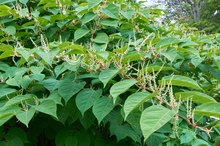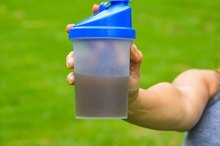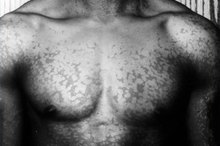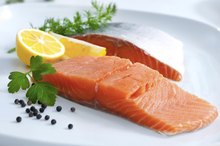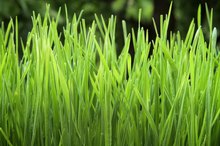The Effects of UV Light on Yeast
Ultraviolet (UV) light is a type of radiation that generally has negative consequences on living cells. However, UV light has the opposite effect on yeast, as the rays can yield increased yeast productivity. The experiments into this interaction between UV light and yeast began in 1920.
Increased Growth and Reproduction
A 1940 study at the University of St. Andrews published in the "BioChem Journal" definitively concluded that UV light exposure releases nitrogenous material from yeast cells. Most of this material is an amino-N substance, which, when released into the surrounding medium of the yeast cells, facilitates their growth and reproduction. This coincides with the results of a 1923 study published in the "University of Chicago Press" that also demonstrated that UV light exposure increases yeast production. In that study, brewer's yeast exhibited a faster rate of fermentation.
- A 1940 study at the University of St. Andrews published in the "BioChem Journal" definitively concluded that UV light exposure releases nitrogenous material from yeast cells.
Membrane Destruction
What Are the Benefits of Japanese Knotweed?
Learn More
UV light does slowly penetrate and destroy the cell membranes of yeast. This process is the likely cause of the cells' release of nitrogenous materials. Similar materials are also released by yeast cells during the outright destruction of cell membranes by other methods. However, UV exposure, when controlled, initiates, but does not complete, cellular breakdown. This has the benefit of releasing growth-inducing compounds into the yeast environment while keeping the cells intact.
- UV light does slowly penetrate and destroy the cell membranes of yeast.
Cell Death
UV light, in large quantities over longer periods of time, does kill yeast cells eventually. A 1920 study published in the "Botanical Gazette" noted that yeast does have a threshold after which it dies from overexposure to UV light. This threshold depends on the strength of the UV light source and the time of exposure. The study noted that as little as three minutes' exposure can kill yeast from high UV light strength, while the University of St. Andrews study exposed the yeast to six hours of UV light, which killed 60 percent of the yeast cells. Thus, a balance between UV intensity and exposure time is necessary for the irradiation to yield desired results.
- UV light, in large quantities over longer periods of time, does kill yeast cells eventually.
- Thus, a balance between UV intensity and exposure time is necessary for the irradiation to yield desired results.
Related Articles
References
- Biochem Journal: The Effect of Ultraviolet Light on Living Yeast Cells Read more: What Is the Effect of UV Light on Yeast?
- Beyond Celiac. Is Yeast Gluten-Free?.
- Bob's Red Mill Natural Foods. Gluten Free.
- Fleischmann's Bread World. Active Dry Yeast.
- Celiac Disease Foundation. Sources of Gluten.
- Bluebonnet Nutrition Corporation. Super Earth Brewer's Yeast Powder 1 lb.
- Foods Alive Inc. Nutritional Yeast - Non-GMO - Non-Fortified.
- NOW Foods. Nutritional Yeast Flakes.
- Nuts.com. Gluten-Free Nutritional Yeast.
- Planned Parenthood. What is a yeast infection?
- InformedHealth.org [Internet]. Cologne, Germany: Institute for Quality and Efficiency in Health Care (IQWiG); 2006-. Vaginal yeast infection (thrush): Overview. 2019 Jun 19.
- Singh A, Verma R, Murari A, Agrawal A. Oral candidiasis: An overview. J Oral Maxillofac Pathol. 2014;18(Suppl 1):S81–S85. doi:10.4103/0973-029X.141325
- Jeanmonod R, Jeanmonod D. Vaginal Candidiasis (Vulvovaginal Candidiasis) [Updated 2020 Feb 4]. In: StatPearls [Internet]. Treasure Island (FL): StatPearls Publishing; 2020 Jan-.
- InformedHealth.org [Internet]. Cologne, Germany: Institute for Quality and Efficiency in Health Care (IQWiG); 2006-. Oral thrush: Overview. 2012 Apr 26 [Updated 2019 Aug 15].
- Blostein F, Levin-sparenberg E, Wagner J, Foxman B. Recurrent vulvovaginal candidiasis. Ann Epidemiol. 2017;27(9):575-582.e3. doi:10.1016/j.annepidem.2017.08.010
- Aguin TJ, Sobel JD. Vulvovaginal candidiasis in pregnancy. Curr Infect Dis Rep. 2015;17(6):462. doi:10.1007/s11908-015-0462-0
- Rajalakshmi R, Kalaivani S. Prevalence of asymptomatic infections in sexually transmitted diseases attendees diagnosed with bacterial vaginosis, vaginal candidiasis, and trichomoniasis. Indian J Sex Transm Dis AIDS. 2016;37(2):139–142. doi:10.4103/0253-7184.192121
- Ringdahl EN. Treatment of recurrent vulvovaginal candidiasis. Am Fam Physician. 2000;61(11):3306-12, 3317.
- Aguin TJ, Sobel JD. Vulvovaginal candidiasis in pregnancy. Curr Infect Dis Rep. 2015 Jun;17(6):462. doi: 10.1007/s11908-015-0462-0.
- Blostein F, Levin-Sparenberg E, Wagner J, Foxman B. Recurrent vulvovaginal candidiasis. Ann Epidemiol. 2017 Sep;27(9):575-582.e3. doi: 10.1016/j.annepidem.2017.08.010.
- Chew SY, Than LT. Vulvovaginal candidosis: contemporary challenges and the future of prophylactic and therapeutic approaches. Mycoses. 2016 May;59(5):262-73. doi: 10.1111/myc.12455.
- Roberts CL, Algert CS, Rickard KL, Morris JM. Treatment of vaginal candidiasis for the prevention of preterm birth: a systematic review and meta-analysis. Syst Rev. 2015 Mar 21;4:31. doi: 10.1186/s13643-015-0018-2.
- Xie HY, Feng D, Wei DM, Mei L, Chen H, Wang X, Fang F. Probiotics for vulvovaginal candidiasis in non-pregnant women. Cochrane Database Syst Rev. 2017 Nov 23;11:CD010496. doi: 10.1002/14651858.CD010496.pub2.
Writer Bio
James Highland started writing professionally in 1998. He has written for the New York Institute of Finance and Chron.com. He has an extensive background in financial investing and has taught computer programming courses for two New York companies. He has a Bachelor of Arts in film production from Indiana University.
